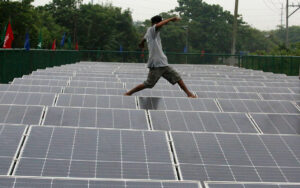By Sheldeen Joy Talavera, Reporter
THE ENERGY Regulatory Commission (ERC) is looking at collecting a green energy auction allowance (GEA-All) from on-grid consumers once the awarded renewable energy (RE) projects start supplying power to the grid.
The ERC has released proposed guidelines on the collection of GEA-All and disbursement of GEA-All Fund. The rules cover emerging RE resources such as solar photovoltaic, biomass, wind, run-of-river hydro, as well as on-grid areas under the GEA program.
“It’s for the collection of the amounts to be paid by consumers to GEA suppliers to be collected by DUs (distribution utilities) for remittance to TransCo (National Transmission Corp.), similar to the… FIT-All (feed-in tariff allowance),” ERC Chairperson and Chief Executive Officer Monalisa C. Dimalanta said in a Viber message.
Ms. Dimalanta said that GEA-All would be a “new collection once these GEA suppliers start supplying power.”
The FIT-All is a uniform charge billed to all on-grid electricity consumers, as a separate line item in a monthly electricity bill, to cover payments to RE developers under the FIT system.
Similarly, GEA-All will be calculated annually and will be charged to on-grid consumers who are supplied with electricity through the distribution or transmission network.
The allowances that will be collected will be remitted to the GEA-All Fund, which will be established and administered by TransCo.
“These collections shall be held by a government financial institution designated as the trustee of the GEA-All Fund, for the sole and exclusive benefit of the GEA plants as beneficiaries, except for amounts allocated to the administration allowance and disbursement allowance,” the regulator said.
The ERC said that a working capital allowance should be established and collected to serve as a buffer “to address any default or delay in the collection and/or remittance of the GEA-All and/or ACRR (actual cost recovery revenue).”
The GEA program aims to promote RE as one of the country’s primary sources of energy through competitive selection. RE developers compete for incentivized fixed power rates by offering their lowest price for a certain capacity.
The green energy auction was first conducted in 2022 and attracted 1,966.93 megawatts (MW) worth of bids for renewables, while GEA-2 was held in 2023 and awarded 3,440.76 MW.
Sought for comment, Pedro H. Maniego, senior policy advisor of the Institute for Climate and Sustainable Cities, said that the proposed GEA-All rules are mainly based on the rules prescribed for FIT-All.
He said that ceiling prices set by the ERC are usually lower than prices at the Wholesale Electricity Spot Market (WESM), the trading floor of electricity.
“Note that even the FIT rates, which were considered high in 2013 and 2015, actually lowered the electricity prices by reducing WESM prices,” he said in a Viber message.
“The installations entitled to GEAR (green energy auction reserve) prices will provide more supply and moderate spot market prices especially during peak demand periods,” he added.
Terry L. Ridon, a public investment analyst and convenor of think tank InfraWatch PH, said that the GEA is an “acceptable market-driven mechanism to reflect the least cost of power to benefit consumers.”
“This should encourage RE developers to continue investing in the country’s remaining RE allocation, as GEA-All sets the clear mechanism towards cost recovery and stable operations,” he said in a Viber message.
“The regulator, however, should continue monitoring price changes and technological innovation within the sector in order to continuously reflect the least cost of power,” he added.
The Department of Energy (DoE) is set to conduct two rounds of green energy auctions this year.
It is preparing to offer an estimated 4,399 MW of capacity under GEA-3. The auction will cater to non-FIT eligible RE technologies such as geothermal, impounding hydro and pumped-storage hydro, as well as run-of-river hydro which is a FIT-eligible RE technology.
For GEA-4, the auction is designed to cover integrated renewable energy and energy storage system. It involves the integration of renewable energy sources with energy storage technologies like batteries, flywheel or pumped storage hydropower system.
The DoE is also considering offering liquefied natural gas capacities for the upcoming round amid “anticipated high entry of renewable energy into the grid resulting from the GEA.”
The Philippine government has set an ambitious goal of increasing the share of RE in the country’s power generation mix to 35% by 2030 and 50% by 2040.






